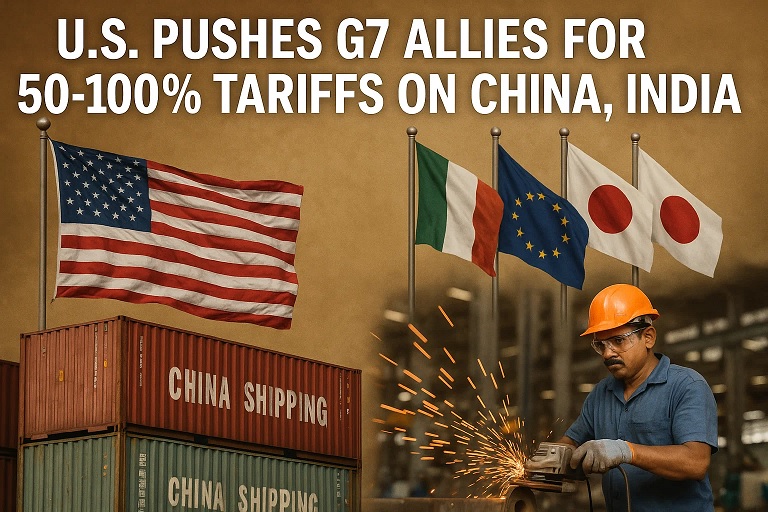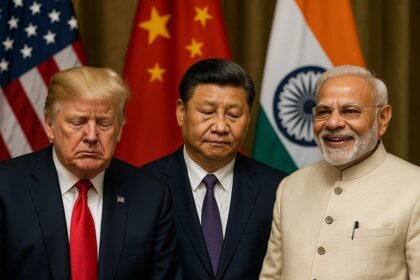U.S. Pushes G7 Allies for 50-100% Tariffs on China, India: Escalating Trade Tensions Over Russian Oil
In a bold escalation of economic pressure tactics, the United States under President Donald Trump is urging its G7 allies to impose tariffs ranging from 50% to 100% on goods from China and India. This push, revealed on September 11, 2025, aims to curb the two nations’ substantial purchases of Russian oil, which the U.S. claims are funding Russia’s ongoing war in Ukraine. As G7 finance ministers convene virtually on September 12, 2025, the proposal highlights deepening geopolitical rifts and could reshape global trade dynamics. With India sourcing over 40% of its oil from Russia and China being the largest buyer, this move signals a broader strategy to isolate Moscow economically. This comprehensive guide delves into the details, implications, and outlook of this high-stakes diplomatic maneuver.
Why the U.S. Push for G7 Tariffs on China and India Matters
The proposal represents a significant shift in international trade policy, extending U.S. unilateral actions to a coordinated G7 effort. By targeting China and India—the world’s two most populous nations and key Russian oil importers—the U.S. seeks to starve Russia of revenue essential for its military operations in Ukraine. This comes amid Trump’s challenges in brokering a peace deal, despite his campaign promises to end the conflict swiftly. For G7 allies, it poses a dilemma: balancing support for Ukraine with economic risks from alienating major trading partners.
Core Objectives of the Tariff Proposal
- Economic Isolation of Russia: Disrupt oil sales that generate billions for Moscow’s war machine.
- Pressure on Buyers: Force China and India to reduce or halt Russian imports through prohibitive tariffs.
- Unified Western Front: Rally G7 nations (Canada, France, Germany, Italy, Japan, UK, U.S.) for collective action.
Latest Events Surrounding the U.S.-G7 Tariff Push
G7 Finance Ministers’ Virtual Meeting on September 12, 2025
On September 12, 2025, G7 finance ministers held a video conference where the U.S. formally proposed the 50-100% tariffs. Sources indicate the U.S. Treasury emphasized that Indian and Chinese oil purchases are prolonging the Ukraine conflict. Canada, as G7 president, confirmed discussions on additional measures against Russia.
Trump’s Lobbying of the EU on September 10, 2025
Just days prior, Trump directly lobbied EU officials for 100% tariffs on China and India during bilateral talks. The EU rejected the idea, citing risks of retaliation and preferring sanctions over tariffs. This rejection has been echoed in real-time social media reactions, with users noting India’s firm stance against bending to U.S. pressure.
U.S. Treasury Secretary’s Remarks on September 11, 2025
U.S. Treasury Secretary Scott Bessent publicly called for stronger European support in escalating economic pressure on Russia, framing the tariffs as essential for peace. Social media buzz highlighted EU’s dismissal of the 100% tariff demand.
Historical Context: U.S. Tariff Strategies and Russia-Ukraine Tensions
U.S. tariff policies under Trump have a precedent in protectionism, starting with his first term’s trade wars. The current push builds on recent actions, including 50% tariffs on Indian goods imposed in August 2025 and hikes on Chinese imports in April 2025. Historically, G7 has focused on sanctions since Russia’s 2022 invasion of Ukraine, but tariffs on third parties mark a new escalation.
Timeline of U.S. Tariff Actions Against China and India
| Date | Event | Details |
|---|---|---|
| April 2025 | Tariffs on Chinese imports | U.S. hikes duties, partially rolled back in May due to market backlash. |
| August 27, 2025 | 50% tariffs on India | 25% reciprocal + 25% punitive for Russian oil buys. |
| September 10, 2025 | EU lobbying | Trump calls for 100% EU tariffs on China/India. |
| September 11, 2025 | FT report on G7 push | U.S. plans revealed for 50-100% G7 tariffs. |
| September 12, 2025 | G7 meeting | Discussions on proposal amid EU hesitation. |
Impacts of Potential 50-100% G7 Tariffs on Global Economy
Economic Repercussions for China and India
For India, additional G7 tariffs could exacerbate the 135,000 job losses from U.S. duties alone, hitting sectors like textiles and gems hard. China faces intensified trade wars, potentially slowing its economy and prompting retaliation. Both nations may pivot to BRICS alliances, deepening ties with Russia.
Geopolitical Shifts and Alliance Strains
The proposal risks fracturing G7 unity, with EU reluctance highlighting transatlantic divides. It could accelerate global de-dollarization and multipolar trade, as India and China seek alternative markets.
Effects on Russia and Ukraine
Reduced oil revenues might force Russia to negotiate, but could also harden Putin’s stance, prolonging the war. Ukraine benefits from added pressure on Moscow, though at the cost of global economic instability.
Future Scopes: Potential Outcomes and Long-Term Scenarios
By 2026, if adopted, tariffs could shave 0.5-1% off global GDP, per analyst projections. India and China may accelerate energy diversification, reducing Russian dependency by 2030. Trump plans talks with Putin and Modi, hinting at possible exemptions for India if trade deals succeed. Long-term, this could spur WTO reforms or new trade blocs.
Possible Scenarios for 2026
- Adoption Path: G7 implements tariffs, leading to short-term disruptions but potential Ukraine peace.
- Rejection Path: EU blocks, forcing U.S. to act unilaterally and straining alliances.
- Compromise Outlook: Partial tariffs with negotiations, balancing pressure and trade stability.
Frequently Asked Questions (FAQs)
What tariffs is the U.S. proposing for G7 allies?
The U.S. is pushing for 50-100% tariffs on Chinese and Indian goods to penalize Russian oil purchases.
Why target China and India specifically?
As top buyers of Russian oil, their imports are seen as funding Russia’s Ukraine war efforts.
Has the EU agreed to the tariffs?
No, the EU has rejected Trump’s 100% tariff call, focusing instead on sanctions.
What is India’s response to the proposal?
India remains firm, continuing Russian oil imports and exploring market diversification.
Could this lead to a broader trade war?
Yes, with risks of retaliation, supply chain chaos, and economic slowdowns worldwide.
The U.S.-G7 Tariff Push: A Pivotal Moment in Global Relations
As the G7 deliberates, this initiative underscores the intersection of trade, energy, and geopolitics. While aimed at hastening Ukraine’s resolution, it risks alienating key emerging powers and reshaping alliances.
Key Takeaways
- Strategic Pressure: Tariffs to cut Russian oil funds.
- Allied Hesitation: EU rejection signals challenges.
- Economic Stakes: Job losses, trade shifts ahead.
- Diplomatic Opportunities: Talks with Modi, Putin ongoing.












